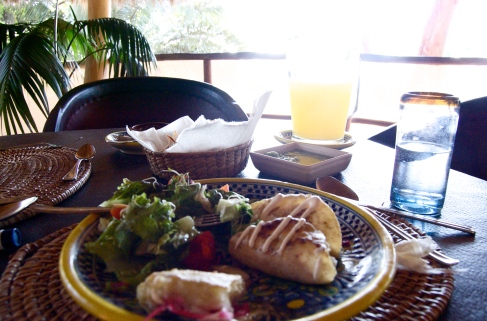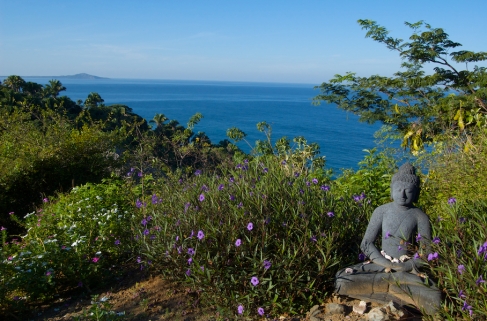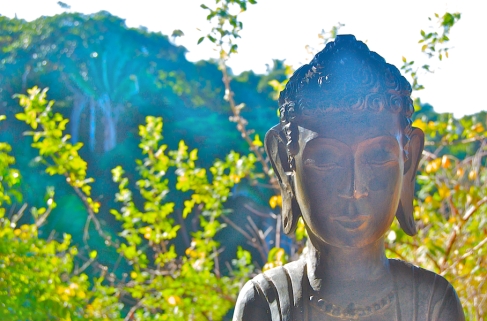When I found out that my favorite yoga teacher was teaching at an 8-day long yoga retreat at a beautifully secluded and ecologically sustainable retreat center on the beaches of Mexico over my birthday, it didn’t take much to convince myself to sign up. Though you wouldn’t know it by my birthday history, I do feel that birthdays are a sacred time for one to reflect upon and celebrate one’s life with a special, self-honoring gesture. And I could think of no better way to do so than with an exotic yoga retreat.
What I regarded as a mere footnote when I signed up was the fact that the retreat was sponsored by VegNews, a local vegan magazine, and the food provided would be entirely vegan. Cool, I thought, it would be cleansing for both mind and body.
What I realized my first night at Haramara, aside from the fact that I could happily spend the rest of my days in an open-air casita in the jungle without electricity, was that veganism is a way of life – a life that all participants at the retreat, minus three of us, were extremely passionate about. There were emotions, politics, research, ethics, and even core yogic principals involved. Not to mention the scars and ongoing tribulations that come with being an all-too-often misunderstood minority. Being vegan in a non-vegan world is hard, and requires a certain level of conviction in order to maintain the commitment to succeed. And I was impressed with the passionate convictions surrounding me at the dinner table.
The food was very good, despite popular vegan stereotypes. I was pleasantly surprised by the wholesomeness, freshness, and creativity of the dishes. Nut and bean spreads, vegetable dips, curries, salads, and even tamales, were part of the 3-course meals we had twice daily, and that is not including the delicious tortilla-based hot breakfasts we could opt for each morning. In short, we were well fed, and I looked forward to every dish.

Though my digestion took a few days to adjust to the new fiber-rich diet, by day 8 I was feeling great. It should be noted here that I have been dealing with digestive issues my entire life, and am always taking note as to how my gut reacts to nuances in my diet. On the flight home I noticed that the usual airplane-stomach pain I get was not there. And when I got home, I noticed that I was not craving any meat, eggs, or dairy. I wanted instead to continue with the fresh, vegetable-based foods from Haramara. A week or so later I felt lighter and cleaner internally, and my digestion wasn’t causing me any issues. I was vegan! A new way of life! A new community! How exciting!
Though it took some time every few nights to prepare a medley of foods to sustain me, I took pleasure in working within these new diet confines. Factory farming woes, as well as fear of hormones and antibiotics in food, became obsolete. I felt that I was eating with an acute sense of awareness and purpose. No living things had to die in order to sustain me….minus the plants. I discovered joy in kale and carrot soup coupled with black bean patties. I realized quickly that having a variety of dishes with different ingredients each week was essential.
And I also started to notice how I loved making these almond flour-based vegan cookies. Only ground nut flour, coconut oil, maple syrup, mesquite powder, and some flax egg. Really healthy, right? What started as a morning snack here and there became a staple in-between meals. Then I started noticing how I ate more and more of them at a time. They started bloating my stomach. And though I felt physically fine, my head was getting foggy. Just feeling a bit…well…not alert.
And it was become increasingly harder to keep up with my cooking regimen. Until one day I broke down and while at the Whole Foods hot bar had a small piece of teriyaki chicken. The guilt! Partially for the animal, but more so for ruining my spotless streak of veganism. It had been almost 2 months! I was doing sooo well! But, shortly after eating the chicken, I noticed that I felt newly satiated. I didn’t really want any almond cookies. And what’s more, I felt some mental energy returning.
(Beautiful beach steps away from the Haramara Retreat center.)
And so began my existential food crisis. My yoga teacher taught us at Haramara that core yoga principals included non-violence (no killing) and no stealing (i.e. milk or eggs). Did eating meat equate to eating unconsciously? Did I need to choose between higher consciousness and optimum physical well-being? (Many vegans would stop me here to say that a vegan diet, when done correctly, does result in optimum physical well-being. While I do not dispute this as true for some, I don’t believe it is true for all bodies, including mine). Was it really necessary to sacrifice health for higher consciousness?
I then started to think of Native American culture. Clearly Native Americans have a great degree of spiritual consciousness. Yet, they ate meat. Albeit, with a high degree of reverence and gratitude, but they killed and ate it all the same. Discounting meat-eaters as not spiritually conscious was ridiculous. Furthermore, Native Americans honor all natural things as sacred, including plants, the ocean, the sun. They feel a sense of unity with all nature, which I resonate with. All things natural to this earth are made from the same energy after all. Plants are still living things. Why is killing a plant much different than killing an animal? Because we don’t see its pain? My own vegan convictions were dissolving rapidly.
(A peony I saved from the ground of the Conservatory of Flowers’ peony garden. It was wilted and sad until I infused it with love and water.)
When I began to gingerly incorporate some chicken and eggs here and there into my diet over the next few days, I noticed an immediate drop in my sugar cravings. It was then that I realized that what I was craving was fat, not sugar. Over the next two weeks, I felt especially nourished by my food, and it tasted more vibrant than ever in my mouth. The two months of being vegan (as well as soy and gluten-free) definitely cleansed my system, and I believe, made it better able to process what I ate. I even noticed that I dropped a couple pounds. What stuck from my veganism was an acute awareness of what I was eating and where it came from. Only local, cage free, organic and naturally-fed chicken and eggs. And no processed foods.
Though I am officially a failed vegan, I respect this lifestyle and applaud the awareness that it fosters. I will never regret my 2-month experiment and appreciate my new-found love of kale. Like anything in our lives, the key to eating is approaching food with awareness and appreciation. Instead of subscribing to a magical one-size-fits-all super diet, I believe that each person needs to learn what diet (and way of life) is right for them by listening to the “laboratory of your own body”, to quote the words of the wise astrologer at Haramara. So true, Coral, so true.













